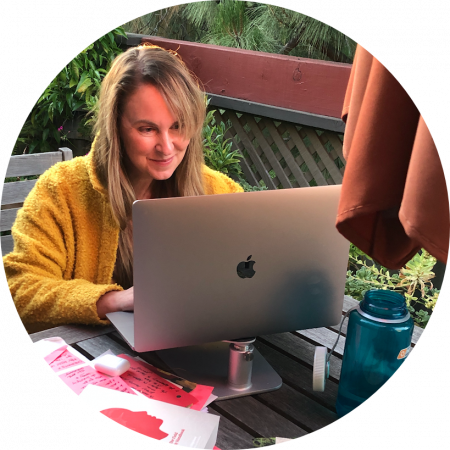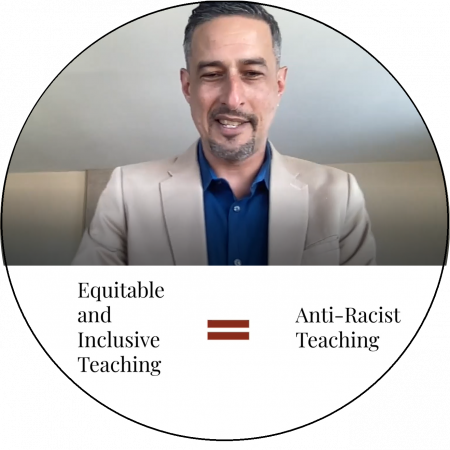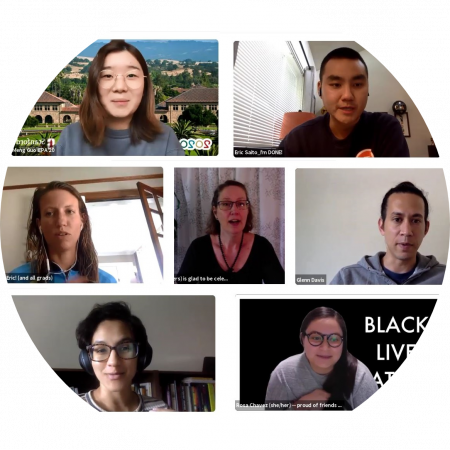
Greta Olivares focuses on maintaining health and fostering engagement in the online setting
Greta Olivares, a GSE alumna, shares how maintaining her health and staying connected with others helped her succeed in online classes
The demands of remote learning can be uniquely stressful. Balancing the mental, emotional, and physical self often requires new strategies in order to maintain health alongside productivity. Explore the below articles and stories about ways to make your classroom a space for students to learn and feel supported in their well-being.

Greta Olivares, a GSE alumna, shares how maintaining her health and staying connected with others helped her succeed in online classes

Melody Wu, an International Education Policy Analysis (IEPA) student, shares how she balances schoolwork and childcare

Lindsey Hasak, a Developmental and Psychological Sciences Program (DAPS) student, shares how she adapted to online learning

GSE instructors discuss which tools and strategies have been most beneficial, and how the remote online environment has impacted student relationships and the ability to effectively learn
Remote classes offer opportunities to think critically about the purpose of a course. Instructors must consider not only what learners engage with, but also where and how learners might access these ideas and experiences within the digital course. Explore some approaches for mapping course content in an intentional and learner-centered way in the articles and stories below.

Alvin Pearman talks about amplifying student voice and setting up a culture of active engagement

Christopher Cormier and Catalina Martinez talk about dynamic teaching methods and the technology they use to facilitate their course

GSE instructors discuss which tools and strategies have been most beneficial, and how the remote online environment has impacted student relationships and the ability to effectively learn

Nadia Gathers and Erika Woolsey reframe how online constraints are an opportunity for innovation in learning and community-building
Online classrooms can offer opportunities for rich interaction. As instructors seek innovative avenues for communication and remixing of ideas, new tools and patterns have emerged that benefit interaction. Explore the below insights towards a more generative and interactive learning environment.

Session highlighting high-impact practices for instructional teams

GSE instructors share their technologies and strategies on how they support active learning in online environments

Mike Hines talks about the importance of focusing on student-centered learning and diverse engagement methods

GSE instructors share their methods, tools, and strategies on how to support the student learning experience and foster engagement in the online setting

A workshop lead by Denise Pope and Laura Easley on how to use teaching and learning to build a connection

A Lunch-n-Learn panel presented by Nicole Ofiesh and Kathryn Gray on how Universal Design for Learning (UDL) fosters better learning outcomes

Fellow teachers share out meaningful moments in class and chat about how they adapted to online learning

Video discussion, escape rooms, and malleable reading lists set the stage for an inclusive and organic learning environment
Online learning can happen synchronously, with instructors and students gathering at the same time and (virtual) place and interacting in “real-time”; or asynchronously, with students accessing materials at their own pace. Explore the stories and resources below for insights on how to incorporate both types of learning and foster continuity across these using hybrid activities

Karla Lomeli, a PhD Candidate in the Race, Inequality, and Language in Education (RILE) program, provides tips on learning from home

Christine Bywater and Sandra Velásquez share tools and workflows for adapting interactive content to an online learning environment

Haley Hemm, a GSE alumna, describes how she kept organized and managed screen time during Spring 2020

Nicole Ardoin talks about the importance of creating class activities that can be completed asynchronously and offline

Jo Boaler shares how whiteboards, journals, and consensus can serve as tools for a learner-centered classroom

Victor Lee shares his remote learning pedagogy and underlying rationale for course design features
Community is the foundation of a conducive learning environment. In digital environments, instructors find it especially important to intentionally build in opportunities for interactions that promote and reinforce students’ sense of connection and belonging. Explore stories and resources for ideas about how to create community, facilitate social interactions and connections, and build student trust in digital environments.

Key strategies for enacting a more equitable and inclusive classroom

GSE instructors reflect over the past year and share strategies that have made a difference in remote instruction

Peer conversation addressing the evolving role of the TA

GSE first-year Ph.D. students chat about choosing classes based on personal and research interests

GSE master’s students reflect on how they built relationships with their cohort

GSE students reflect on what made their classes unique and share hopes for the next quarter

GSE instructors discuss the importance of accessibility, digital inclusion, and accommodation

Jarita Greyeyes, a third-year Race, Inequality, and Language in Education (RILE) student, shares how she copes with the stresses of her program

Hannah Katherine D’Apice, a International Comparative Education (ICE) Ph.D. student, shares collaborating methods and tools for the online setting

GSE students and alumni reflect on their online classroom experiences, how far they have come as online learners, and plans for the future

Mathieu Penot, a Learning, Design and Technology (LDT) MA student, provides tips on how he managed online classes

Fellow teachers share out meaningful moments in class and chat about how they adapted to online learning

Sean Reardon and his teaching team create opportunities for levity while building a space for collective learning
Frequent and varied opportunities for assessment and feedback are key to understanding where students are at. Intentional feedback points can deliver these insights and help to adapt a course accordingly. But gathering feedback can pose distinct challenges depending on the data, student, and learning environment. Explore these ideas and more through the articles and stories below as we consider what assessment online can look like.

Strategies for assessment to power learning and collective ideation

Hannah Johnstone, a GSE alumna, describes her challenges with online learning and offers some promising practices for remote learning

Nadia Gathers and Erika Woolsey reframe how online constraints are an opportunity for innovation in learning and community-building